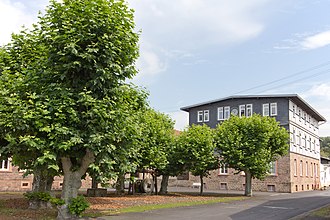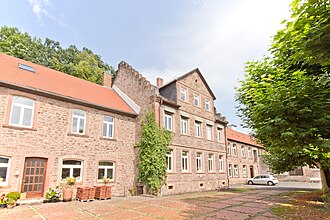Waechtersbach ceramics

The Waechtersbacher ceramics in the Hessian Brachttal- Schlierbach near the eponymous town Wächtersbach was 1832 founded and exists as a production site since 2011 no more. Between the end of the 19th and the middle of the 20th century, it was one of the most important German manufacturers of earthenware , both in terms of the scope of production and its design quality . WAECHTERSBACH GERMANY is currently a brand of Könitz Porzellan GmbH in Unterwellenborn . Production is currently in China, Thailand and Germany (Unterwellenborn-Könitz).
history
In 1829 an occurrence of white clay was discovered in the Ysenburg-Waechtersbach forest, in the Leite district . An investigation showed that it was "excellently suited for the production of earthenware products". The other minerals required for production such as pebbles, tufa and white sand were also found in the vicinity. On June 8, 1832, Count Adolf II von Ysenburg-Wächtersbach and other partners founded an earthenware factory in Weilers , the Waechtersbacher Keramik. "The company consisted of 7 partners, 5 of whom lived in Wächtersbach and 2 in Schlierbach". On October 1, 1832, production began in a rented farmhouse in Weilers. The necessary grinding work for processing the minerals was done in the rented Hesseldorfer mill. After the company had its own mill with the acquisition of the Schlierbacher Mühle an der Bracht on May 7, 1833, production was relocated to Schlierbach on January 1, 1834, where it was systematically expanded over the years.
In the early years from 1832 to around 1845, it mainly produced simple, white tableware. In 1840 the copper transfer printing process was introduced for artistic decoration, and in 1870 stone color printing .
"In 1857 the factory became the property of the Prince of Ysenburg-Wächtersbach",…. In the same year "... the railway line from Hanau am Main to Wächtersbach" was put into operation. "This made the dispatch of goods and the procurement of raw materials much easier."
The scope and quality of production increased until the end of the 19th century, when the factory reached its first peak in historicism from the summer of 1874 under the technical and commercial management of Max Roesler . Extremely high quality and technically complex work is evidence of the high standard of manufacture, which has been copied by many competitors. While Waechtersbach ceramics were only represented locally until now, they now supplied the entire German Empire .
Roesler also took care of the social issues of his employees. In 1877, for example, he founded a factory savings bank to enable workers to buy houses. Furthermore, a handicraft school for young girls and a workers' music association were set up. As early as 1884 a college of elders was established for disciplinary matters and in 1888 a company newspaper , the Schlierbacher factory messenger .
In 1890, after 16 years of extremely fruitful activity, Max Roesler left the factory in a dispute because Prince Bruno zu Ysenburg and Büdingen refused to participate in the company. A few years later, in 1894, he founded the Max Roesler Feinsteingutfabrik in Rodach .
On April 1, 1901, Christian Neureuther was allowed to found the ceramic studio in Wächtersbach with the consent of the factory management of the Wächtersbach stoneware factory. It was not until 1903 that the director Dr. Honestly to add an independent ceramic art department under Christian Neureuther to Ferdinand Maximilian zu Ysenburg and Büdingen in Wächtersbach within the Wächtersbach stoneware factory.
From 1900 onwards, the Wächtersbacher Steingutfabrik and Neureuther participated in the execution of some ceramic designs that came from Joseph Maria Olbrich and Hans Christiansen and were intended for the first Darmstadt exhibition - A Document of German Art. The factory received the Darmstadt 1901 plaque for this . For the second exhibition of the Darmstadt artists' colony in 1904, several vases were made based on designs by Paul Haustein . In around 1906 he worked with Albin Müller , the then new member of the Darmstadt artists' colony . The late romantic Johann Georg Mohr and Joseph Kaspar Correggio also designed for the Wächtersbach stoneware factory.
Due to the enormous success and the pioneering designs, the company was able to leave competitors like Villeroy & Boch far behind. After Neureuther's death in 1921, the art department was taken over by Eduard Schweitzer, but closed again in 1929. Nevertheless, in the 1930s, Dina Kuhn and Ursula Fesca from Vienna were hired as two other renowned designers. Fesca implemented Bauhaus ideas very early on and designed series that were so far ahead of the general taste of the time that they were only produced after the Second World War . Fesca left the factory from 1939 to 1945 due to illness. Because of this, and because of rigid production restrictions, a decline began in terms of capacity, quality and innovation.
After the Second World War, production could be resumed with Ms. Fesca and Waechtersbach developed into the largest ceramic manufacturer in Germany. The company has also been exporting its products to America since the 1960s. Waechtersbach ceramics has attracted the interest of art collectors in recent years and has become an object of the antique trade.
Recent company history
On January 21, 2005, after 173 years of family ownership, the factory was sold to BEFI GmbH in Wain near Laupheim. With the decision of the Hanau Local Court on January 1, 2006, insolvency proceedings were opened against the company's assets . "The company was then able to continue under difficult economic conditions," said a press release.
On June 28, 2006, managing director Klaus-D. Michels and attorney Göran Berger inform that the company, which is in the insolvency proceedings, intends to suspend production in July 2006 and to release its employees for one month on July 1, 2006. In mid-September 2006, production in Schlierbach was restarted after an almost three-month break. The Waechtersbacher Keramik was taken over by Turpin Rosenthal, a former Ikea manager, in September 2006, divided into several individual companies and run as a subsidiary of Könitz Porzellan GmbH . One of these sole proprietorships was the Brachttal GmbH ceramic factory. In September 2011 she filed for bankruptcy. The plant in Brachttal-Schlierbach was closed in this context. On May 30, 2012, almost the entire inventory of the company was auctioned by the company Perlick Industriauktionen on behalf of the insolvency administrator Franz-Ludwig Danko and Turpin Rosenthal's company Könitz Porzellan. In 2013 Turpin Rosenthal opened a show production at the Schlierbach site with the remaining employees. In the summer of 2018, the Main-Kinzig district bought the company archive of "Waechtersbacher Keramik" from the property of the Könitz Group. In addition to the paper archive with sketch and decor books, it includes 3000 copper and metal printing plates as well as the ceramics collection from the former production.
Collections
Significant holdings of historical Waechtersbach ceramics can be found in the following museums:
- Hessian State Museum Kassel
- Hessian State Museum Darmstadt
- Vonderau Museum , Fulda
- Museum of Applied Arts , Frankfurt am Main
- Jever Castle Museum
- Lindenhof Museum, Brachttal-Streitberg
- Brachttal Museum , Brachttal-Spielberg
- Wächtersbach local history museum
literature
- J. Ackermann, "From mills and millers near Hesseldorf", Samml. Gesch. Wächtersbach, 40. L., August 2002, No. 262, ISSN 0931-2641
- Neureuther, Christian (Publisher: Strauch & Zahn, Hamburg): Ornaments (10 sheets + title). Hamburg / Schlierbach probably 1900/01.
- Wächtersbacher Steingutfabrik Schlierbach near Wächtersbach (ed.): The strike in Schlierbach (separate impression from Keramische Rundschau, 66 pages). Schlierbach 1904.
- Ruppel, Jacob: The history of the earthenware factory, set up by Jacob Ruppel in 1876 . Schlierbach 1907.
- Eckstein's biographical publishing house Berlin: Historically biographical sheets - industry, trade and commerce: history of the Wächtersbacher stoneware factory . Berlin, no year (approx. 1910/11).
- Wächtersbacher Steingutfabrik GmbH / Verlag DIE SCHAULADE GMBH, Bamberg (ed.): Hundert Jahre Waechtersbach (1832-1932) - on June 8, 1932 (42 pages, anniversary brochure). Bamberg / Schlierbach 1932.
- Department of Culture and Leisure, Museum of Arts and Crafts (today: Museum of Applied Arts) City of Frankfurt am Main (publisher): Kleine Hefte, Nr. 8, Wächtersbacher Steingut - exhibition from 27.9. until November 12, 1978 . Frankfurt am Main 1978.
- Wächtersbacher Keramik (Ed.): Color Comedies - International Architects and Designer Workshop of Waechtersbacher Keramik - Michael Graves , Zaha Hadid , Elizabeth Garouste / Mattia Bonetti, Atsushi Kitagawara, Jo Laubner and Ettore Sottsass . 1992, ISBN 3-926048-90-5 .
- Frensch, Heinz / Frensch, Lilo: Wächtersbach stoneware . Koenigstein i. Ts. (Langewiesche Nachf. KG) 1978, 2nd, unchanged edition 1995, ISBN 3-7845-7950-7 .
- Wurzel, Thomas (Hrsg.): Exhibition catalog "Wächtersbacher Steingut - The Sparkassen-Kulturstiftung Hessen-Thüringen". Kassel 2001.
- Rinn, Ludwig / Vonderau Museum, Fulda (ed.): Wächtersbacher ceramics brand panel . 2002, ISBN 3-935590-28-8 .
- Kirchner, Volker (ed.): The big strike in the Wächtersbach stoneware factory . Brachttal 2004.
- Schulte-Wülwer, Ulrich / Museumsberg Flensburg (ed.): Wächtersbacher earthenware. The Angelika Jensen Collection . Flensburg 2006.
- Berting, Ulrich / Neidhardt, Erich (ed.): Wächtersbacher earthenware - figures and figurative things . Brachttal 2007.
- Hess, Pascal; Museum of Applied Arts Frankfurt (ed.): Wächtersbacher ceramics, play of skin and body . Frankfurt 2008.
- Brachttal-Museum (Ed.): Exhibition catalog Wächtersbacher Steingut - The Twenties . Brachttal 2011.
- Museum Kurhaus Kleve (Ed.): Exhibition catalog Trends in German Ceramics 1905-1935 - From Art Nouveau to Bauhaus . Kleve 2012.
- Mülot, Nora (Ed.): "Waechtersbach and the Atelier Christian Neureuther 1903 to 1921", ET 01/2017.
- Brachttal-Museum (Ed.): Wächtersbacher stoneware - 180 years . Brachttal 2015, ISBN 978-3-00-049175-7 .
Web links
Individual evidence
- ↑ J. Ackermann, "From mills and millers near Hesseldorf", Samml. Gesch. Wächtersbach, 40. L., August 2002, No. 262, ISSN 0931-2641, p. 5
- ^ Adolf II of Ysenburg-Wächtersbach
- ^ A. Amend and E. Lerch, "Von der Wächtersbacher Steingutfabrik in Schlierbach", home book of the district of Gelnhausen, by Martin Schäfer, publisher. District administration Gelnhausen, 1950, p. 7
- ↑ Eberhard Traum, In love with detail: created by designers from different eras ...
- ^ A. Amend and E. Lerch, "Von der Wächtersbacher Steingutfabrik in Schlierbach", home book of the district of Gelnhausen, by Martin Schäfer, publisher. District administration Gelnhausen, 1950, p. 7
- ^ Frankfurter Rundschau: Waechtersbacher ceramics completely at the end , accessed on October 12, 2011
- ↑ Gelnhäuser Tagesblatt: "Production is back in Schlierbach" ( Memento from December 31, 2013 in the web archive archive.today )
- ↑ Luise Glaser-Lotz: Printing plates, sketches and decor books. In: www.faz.net. August 11, 2018. Retrieved August 11, 2018 .



